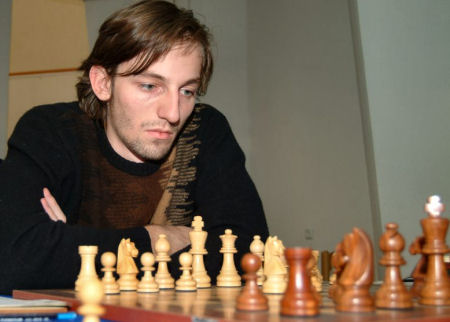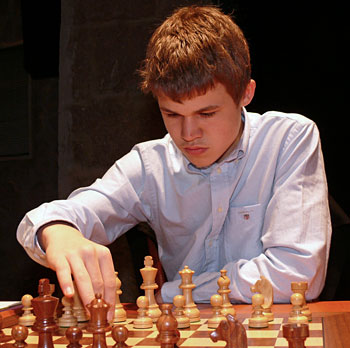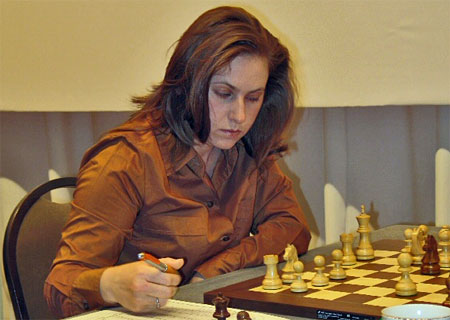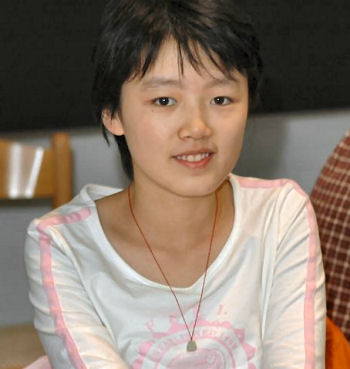| Latest | Greatest | Lobby | Journals | Search | Options | Help | Login |
|
|
|
This topic is archived. |
| Home » Discuss » Topic Forums » Sports |
|
| Jack Rabbit
|
Sun Jun-10-07 02:41 PM Original message |
| The Jack Rabbit Chess Report for June 10: Leko ½ point from Mexico City |
|
Edited on Sun Jun-10-07 03:00 PM by Jack Rabbit
The Jack Rabbit Chess Report for the week ending June 10 Candidates' Final Matches in Elista  from Chess Central Website of Veronica Kasatkina Contents Post 1: News for the week Post 2: Diagrams and other features Post 3: Games from Current and Recent Events |
| Printer Friendly | Permalink | | Top |
| Jack Rabbit
|
Sun Jun-10-07 02:42 PM Response to Original message |
| 1. News for the week ending June 10 |
|
Candidates Matches in Elista: Leko ½ point away from Mexico City
 Hungarian grandmaster Peter Leko need only avoid loss in his fifth match game agains Evgeny Bareev tomorrow in Elista, Kalmykia (Russia) in order to qualify for September's World Championship Tournament in Mexico City. One thing upon which Leko's admirers and detractors agree is that Leko knows how to avoid loss. Leko has a 3-1 lead over Bareev after today's fouth round game ended in a draw. Bareev must win the two remaining games tomorrow and Tuesday in order to force a playoff of four rapid games Wednesday. As if the two-game disadvantage were not enough for Bareev to overcome, he must do this against Leko, perhaps the most difficult grandmaster in the world to defeat. Leko will play White tomorrow. Rublevsky, Grischuk knotted In another game today, former Russian national champion Sergey Rublevsky defeated fellow Russian grandmaster Alexander Grischuk in 66 moves to knot their match at two points apiece. Grischuk won the first game of the match Wednesday and the second and third games were draws. Today's game, in which Rublevsky played White, began as an Open Royal Game (more commonly called the Scotch Opening), at which Rublevsky is the world's leading practioner. At the end of the game, White was three pawns up ready to deliver mate on the next move. Candidates' Matches Finals Elista Levon Aronian. . . .1 ½ ½ ½ * * .. - 2½ . . . . . . Peter Leko . . . . .1 ½ 1 ½ * * .. - 3. Alexey Shirov. . . .0 ½ ½ ½ * * .. - 1½ . . . . . . Evgeny Bareev. . . .0 ½ 0 ½ * * .. - 1. Alexander Grischuk .1 ½ ½ 0 * * .. - 2. . . . . . . Gata Kamsky. . . . .½ ½ 0 ½ * * .. - 1½ Sergey Rublevsky . .0 ½ ½ 1 * * .. - 2. . . . . . . Boris Gelfand. . . .½ ½ 1 ½ * * .. - 2½ The other two games today ended in draws. In those matches, Armenian grandmaster Levon Aronian leads Latvian-born Spaniard Alexey Shirov, 2½-1½, and in a battle of two Soviet expatriots, Israeli grandmaster Boris Gelfand is ahead of Gata Kamsky of the United States, 2½-1½. Each match is scheduled for six games, with the last two rounds to be played tomorrow and Tuesday. Any match that is knotted at 3 points apiece after six games will be decided in a playoff of rapid and, if necessary, blitz games on Wednesday. The four match winners will play in the World championship Tournament in Mexico City in Spetember with four seeded players, reigning world champion Vladimir Kramnik, Russian grandmaster Alexander Morozevich and Peter Leko and the number one ranked player in the world, India's Vishy Anand. National Open in Las Vegas concludes this evening  The National Open, part of the Las Vegas International Chess Festival, concludes today with the final two rounds of the six-round Swiss system tournament. Round 5 will begin at 11 am PDT and Round 6 is scheduled for 6 pm. After four rounds, two players have perfect scores: Bulgarian grandmaster Atanas Kolev and IM Renier Gonzalez of Florida. Several players are on their heels with 3½ points, including the grand old man of chess, Viktor Korchnoi. US champion Alex Shabalov is at 3 points, as is the leading lady of American chess, Irina Krush. |
| Printer Friendly | Permalink | | Top |
| Jack Rabbit
|
Mon Jun-11-07 11:26 AM Response to Reply #1 |
| 11. Updates: Leko and Gelfand win in Elista; Nakamura hits jackpot in Vegas |
|
Edited on Mon Jun-11-07 11:29 AM by Jack Rabbit
Candiates Finals/Round 5: Leko and Gelfand qualify for Mexico City
 Israeli grandmaster Boris Gelfand, playing Black, defeated American Gata Kamsky in 53 moves a few minutes ago to win their candidates' final match in Elista, the capital of the autonomous Russian republic of Kalmykia, by a score of 3½-1½. Kamsky was in a must win situation today and courageously fought on in a lost position for much of the game. In another game today, Peter Leko of Hungary agreed to a draw with Russian grandmaster Evgeny Bareev to win their match, 3½-1½. The match victories qualify Leko and Gelfand to play in the World Championship Tournament in Mexico City beginning September 9. The two other games today, one between Armenian grandmaster Levon Aronian and Latvian-Spanish grandmaster Alexey Shirov and the other between Russians Alexander Grischuk and Sergey Rublevsky, also ended in draws. Aronian leads Shriov 3-2 and need only aboid loss in tomorrow's game to qualify for the tournament in Mexico City. Shirov will play White. The match between Grischuk and Rublevsky is knotted at 2½ points each with both players needing a win tomorrow to qualify for Mexico City. Should that game, in which Rublevsky will play White, end in a draw, a set of four rapid games will be played Wednesday followed by two blitz games, if necessary, to determine the winner of the match. Nakamura wins National Open in Las Vegas  New York grandmaster Hikaru Nakamura defeated Reiner Gonzales, an international master from Florida, in 84 moves to win a clear first prize in the National Open in Las Vegas last night. The win gave Nakamura 5½ points in the six-round Swiss system event. Gonzales was leading the tournament with a perfect score after five rounds with Nakamura only a half point behind at the start of the final round. Six players finished tied for second at 5 points each, including Gonzales and the legendary 76-year-old Russo-Swiss grandmaster Viktor Korchnoi. |
| Printer Friendly | Permalink | | Top |
| Jack Rabbit
|
Wed Jun-13-07 04:17 PM Response to Reply #1 |
| 12. Update 2: Aronian and Grischuk bound for Mexico City |
|
Details Sunday.
|
| Printer Friendly | Permalink | | Top |
| Jack Rabbit
|
Sun Jun-10-07 02:43 PM Response to Original message |
| 2. Diagrams and other features of the JR Chess Report |
|
!""""""""# $tMvWlVmT% $OoOoOoOo% $ + + + +% $+ + + + % $ + + + +% $+ + + + % $pPpPpPpP% $RnBqKbNr% /(((((((() White to move This position is a theoretical draw Does this picture make sense to you? If not, or if it looks like a bunch of Wingdings, please click here. Diagrams used in the Jack Rabbit Chess Report are made with Chess Merida, a true type font that is available as freeware at the above link. Also, the JR chess report makes the main variation in annotations more distinct and readable by putting it in red. A secondary variation, is in blue and other colors are used if needed. |
| Printer Friendly | Permalink | | Top |
| Jack Rabbit
|
Sun Jun-10-07 02:44 PM Response to Reply #2 |
| 3. oops |
|
Edited on Sun Jun-10-07 02:46 PM by Jack Rabbit
|
| Printer Friendly | Permalink | | Top |
| Jack Rabbit
|
Sun Jun-10-07 02:45 PM Response to Original message |
| 4. Games from current and recent events |
|
Edited on Sun Jun-10-07 03:04 PM by Jack Rabbit
Chess Games Analysis by JR and Fritz (4.01 and 6.0) Alexander Grischuk - Sergey Rublevsky, Candidtes' Final Match, Round 1, Elista Levon Aronian - Magnus Carlsen, Candidtes' Semi-Final Match, Round 4, Elista Evgeny Bareev - Judit Polgar, Candidtes' Semi-Final Match, Round 4, Elista Magnus Carlsen - Levon Aronian, Candidtes' Semi-Final Match, Round 5, Elista Judit Polgar - Evgeny Bareev, Candidtes' Semi-Final Match, Round 5, Elista Sopio Gvetadze - Shen Yang, Women's World Team Championship, Round 5, Ekaterinburg |
| Printer Friendly | Permalink | | Top |
| Jack Rabbit
|
Sun Jun-10-07 02:47 PM Response to Reply #4 |
| 5. Grischuk - Rublevsky, Finals, Round 1, Elista |
 Alexander Grischuk Alexander Grischuk vs. Sergey Rublevsky Candidates' Final Match, Round 1 Elista, June 2007 Open Sicilian Game: Scheveningen Defense 1. e4 c5 2. Nf3 e6 3. d4 cxd4 4. Nxd4 Nc6 5. Nc3 a6 6. Be2 d6
Black: Sergey Rublevsky !""""""""# $t+ +vTl+% $+o+mVoOo% $oPw+o+ +% $+ +oP + % $p+ Q P +% $+ N Bb+ % $ +p+ +pP% $+ + RrK % /(((((((() White: Alexander Grischuk Position after 17. -- Nf6d7 18. Nxd5!!
Black: Sergey Rublevsky !""""""""# $ + TvTl+% $+o+ +o+o% $oP +pO +% $+ B + + % $p+ + P +% $+b+ + + % $ +p+ +pP% $+ + Rr+k% /(((((((() White: Alexander Grischuk Position after 24. -- gf6:B 25. e7!!
30. -- Rf1+ 31. Kh2 Rf2 Black: Sergey Rublevsky !""""""""# $ + + Tl+% $+oR Ro+o% $oPv+ O +% $+ + + + % $p+ + + +% $+b+ + +p% $ +p+ TpK% $+ + + + % /(((((((() White: Alexander Grischuk Position after 31. -- Rf1f2 32. Rxc6!!
|
| Printer Friendly | Permalink | | Top |
| Jack Rabbit
|
Sun Jun-10-07 02:48 PM Response to Reply #4 |
| 6. Aronian - Carlsen, Semi-Fianls, Round 4, Elista |
 Levon Aronian Levon Aronian vs. Magnus Carlsen Candidates' Semi-Final Match, Round 4 Elista, May 2007 East India Game: Bogo-Indian Defense 1. d4 Nf6 2. Nf3 e6 3. c4 Bb4+ 4. Nbd2
Black: Magnus Carlsen !""""""""# $ +t+ Tl+% $Ov+mWoO % $ O +o+ O% $+ + + + % $ PbN + +% $P + P + % $ B +qPpP% $T T + K % /(((((((() White: Levon Aronian Position after 15. -- h7h6 16. Ba6!!
Black: Magnus Carlsen !""""""""# $ M + Tl+% $O + WoO % $ O +oM O% $+ + + + % $ PqN + +% $P + P + % $ B + PpP% $+ R + K % /(((((((() White: Levon Aronian Position after 19. Qa6c4
Black: Magnus Carlsen !""""""""# $ M T +l+% $O + W O % $ O + O O% $+p+ Oq+ % $p+ + + +% $+ + P +p% $ B + Pp+% $+ R + K % /(((((((() White: Levon Aronian Position after 28. -- f7f6 29. Qe4!
|
| Printer Friendly | Permalink | | Top |
| Jack Rabbit
|
Sun Jun-10-07 02:49 PM Response to Reply #4 |
| 7. Bareev - J. Polgar, Semi-Fianls, Round 4, Elista |
 Evgeny Bareev Evgeny Bareev vs. Judit Polgar Candidates' Semi-Final Match, Round 4 Elista, May 2007 East India Game: Queen's Indian Defense (Catalan Opening) 1. d4 Nf6 2. c4 e6 3. Nf3 b6 4. g3 Bb7 5. Bg2 Be7 6. 0-0 0-0 7. Nc3 Ne4
Black: Judit Polgar !""""""""# $t+ +t+l+% $O +w+oVo% $ + O Mo+% $P Op+ + % $ O +pP +% $+p+ + P % $ BqN + P% $R + R K % /(((((((() White: Evgeny Bareev Position after 23. -- Qd8d7 24. Nc4!
Black: Judit Polgar !""""""""# $ + Tt+l+% $O + +wMo% $ + P + +% $P O O O % $ On+ +p+% $+p+ + +p% $ + + +q+% $+ +rR K % /(((((((() White: Evgeny Bareev Position after 32. -- Qd7f7 33. Qd5!
Black: Judit Polgar !""""""""# $ + + + +% $R + + +o% $ + + +l+% $P O + + % $ OnMk+pP% $+p+ + + % $ + + + T% $+ + + + % /(((((((() White: Evgeny Bareev Position after 45. -- Rc2h2 46. a6!
|
| Printer Friendly | Permalink | | Top |
| Jack Rabbit
|
Sun Jun-10-07 02:50 PM Response to Reply #4 |
| 8. Carlsen - Aronian Semi-Fianls, Round 5, Elista |
 Magnus Carlsen Magnus Carlsen vs. Levon Aronian Candidates' Semi-Final Match, Round 5 Elista, June 2007 East India Game: Queen's Indian Defense (Petrosian Opening) 1. d4 Nf6 2. c4 e6 3. Nf3 b6 4. a3 Bb7 5. Nc3 d5 6. cxd5 Nxd5 7. Qc2 Be7 8. e4 Nxc3 9. bxc3 0-0 10. Bd3 c5 11. 0-0 Qc7
Black: Levon Aronian !""""""""# $t+ + Tl+% $+ W VoOo% $vM +o+ +% $+ + P B % $ OoP + +% $+ P +N+ % $ +b+qPpP% $+r+ +rK % /(((((((() White: Magnus Carlsen Position after 19. -- Nd7b6 20. Qe4!
Black: Levon Aronian !""""""""# $ + + Tl+% $T + +o+o% $v+ +oPo+% $+ +m+ + % $ OoPvW Q% $+ P +n+ % $ + + PpP% $+r+ +rK % /(((((((() White: Magnus Carlsen Position after 24. -- Qc7f4 25. Bxd5!
Black: Levon Aronian !""""""""# $ R + + +% $+ + +p+l% $ + +v+ O% $+ +pN +o% $ +p+ P +% $+ T + + % $ + + +pK% $+ + + + % /(((((((() White: Magnus Carlsen Position after 37. -- gh5:p 38. Rf8!
|
| Printer Friendly | Permalink | | Top |
| Jack Rabbit
|
Sun Jun-10-07 02:51 PM Response to Reply #4 |
| 9. J. Polgar - Bareev, Semi-Fianls, Round 5, Elista |
 Judit Polgar Judit Polgar vs. Evgeny Bareev Candidates' Semi-Final Match, Round 5 Elista, June 2007 German Game: Two Knights' Clam Opening (Caro-Kann Defense) 1. e4 c6 2. Nc3 d5 3. Nf3
Black: Evgeny Bareev !""""""""# $t+ +l+ T% $+o+ +oVO% $ Wo+ MO+% $O MoO + % $p+ +p+o+% $+ +p+q+p% $ PpBbP +% $R +n+rK % /(((((((() White: Judit Polgar Position after 13. -- Nd7c5 14. g5?
Black: Evgeny Bareev !""""""""# $t+ + Tl+% $+o+m+ Vo% $ Wo+o+o+% $O + O P % $p+ +p+ P% $+ + +q+ % $ PpB P +% $T +n+rK % /(((((((() White: Judit Polgar Position after 18. -- fe6:B 19. Qh3!
Black: Evgeny Bareev !""""""""# $t+ + T L% $+o+r+ Vo% $ +o+q+ +% $O + O Po% $p+ +p+ +% $+ N + + % $ W + P +% $+ + +rK % /(((((((() White: Judit Polgar Position after 24. -- Kg8h8 25. Rxg7!!
|
| Printer Friendly | Permalink | | Top |
| Jack Rabbit
|
Sun Jun-10-07 02:53 PM Response to Reply #4 |
| 10. Gvetadze - Shen Yang, Round 4, Ekaterinburg |
 Shen Yang Sopio Gvetadze (Georgia) vs. Shen Yang (China) Women's World Team Championship, Round 4 Ekaterinburg, May 2007 Spanish Grand Royal Game: Clam Opening 1. e4 e5 2. Nf3 Nc6 3. Bb5 a6 4. Ba4 Nf6 5. d3
Black: Sopio Gvetadze !""""""""# $ + MtT L% $+vOw+ Vo% $ + + +o+% $+o+ Oo+m% $ + + + B% $+ PpN +p% $ PbN Pp+% $R +qR K % /(((((((() White: Shen Yang Position after 20. -- Nf6d8 21. f3?!
Black: Sopio Gvetadze !""""""""# $v+ +tT L% $R O + Vo% $ + Wm+o+% $+o+ Oo+ % $ + + M B% $+nPpNp+p% $ Pb+ +p+% $+ +qR +k% /(((((((() White: Shen Yang Position after 25. Kh2h1 25. -- Bh6?!
Black: Sopio Gvetadze !""""""""# $v+ T T L% $R O + Vo% $ + +mWo+% $+o+ +o+ % $ + + M +% $+nP Np+p% $ Pb+ Bp+% $+q+ + Rk% /(((((((() White: Shen Yang Position after 30.Re1g1 30. -- Nxh3!!
|
| Printer Friendly | Permalink | | Top |
| DU
AdBot (1000+ posts) |
Tue Apr 23rd 2024, 10:09 PM Response to Original message |
| Advertisements [?] |
| Top |
| Home » Discuss » Topic Forums » Sports |
|
Powered by DCForum+ Version 1.1 Copyright 1997-2002 DCScripts.com
Software has been extensively modified by the DU administrators
Important Notices: By participating on this discussion board, visitors agree to abide by the rules outlined on our Rules page. Messages posted on the Democratic Underground Discussion Forums are the opinions of the individuals who post them, and do not necessarily represent the opinions of Democratic Underground, LLC.
Home | Discussion Forums | Journals | Store | Donate
About DU | Contact Us | Privacy Policy
Got a message for Democratic Underground? Click here to send us a message.
© 2001 - 2011 Democratic Underground, LLC